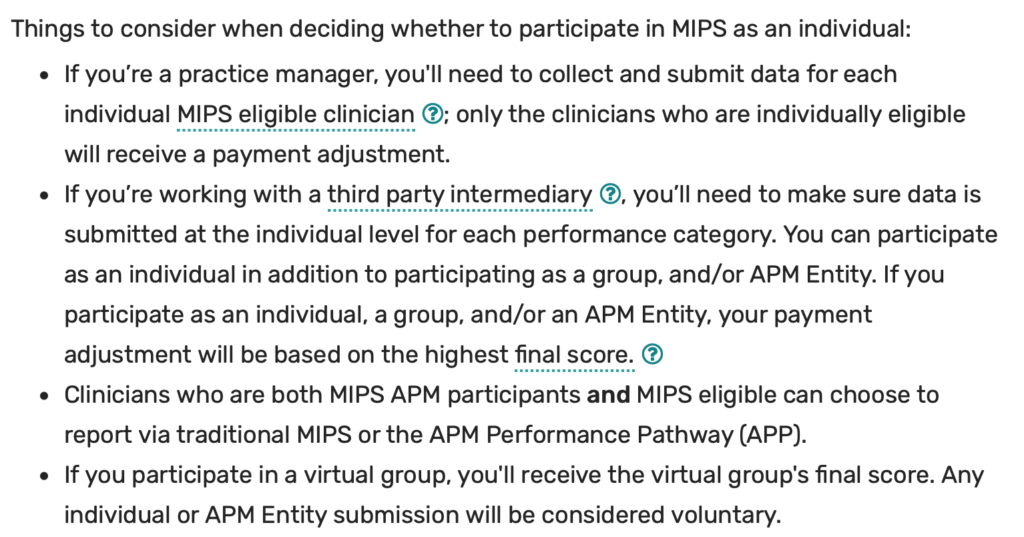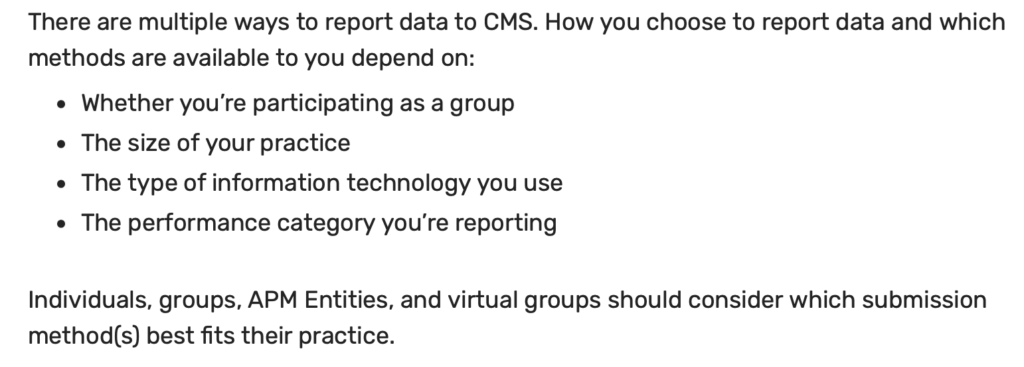One of the benefits of reporting for MIPS is that practices and clinicians can choose the participating option that best fits their needs. The participation options available to you depend on your eligibility status and chosen reporting option(s). If you plan on reporting for Traditional MIPS rather than through the MIPS APM or MVPs, you’ll have the opportunity to report either as an individual or as a group. Here are the differences between individual and group reporting for Traditional MIPS.
Individual Reporting
CMS says that an individual is defined as “a single clinician, identified by a single National Provider Identifier (NPI) number tied to a single TIN.” You can participate in MIPS as an individual if you’re eligible to participate in MIPS at the individual level or opt-in eligible as an individual. Clinicians reporting this way are required to independently complete the process of reporting and submitting data for MIPS in three performance categories: Quality, Improvement Activities, and Promoting Interoperability.
The benefit of reporting as an individual is that you don’t have to rely on the work of other clinicians when determining your data, ultimately making your Final Score representative exclusively of your own work. However, this means that you are entirely responsible for the MIPS reporting and submission process.
CMS also provides the following information for those planning to report as an individual:

Important! If you’re MIPS eligible as an Individual, you’re required to participate in MIPS.
Group Reporting
CMS defines a group as “a single TIN with two or more eligible clinicians (including at least one MIPS eligible clinician), as identified by their NPI, who have reassigned their Medicare billing rights to the TIN.” A practice can participate as a group if the practice exceeds the low-volume threshold and is MIPS eligible, or opt-in eligible, at the practice level. There is no requirement for a practice that is eligible as a group to participate as a group.
However, there are many benefits to reporting for MIPS as a group, including but not limited to:
- Sharing the MIPS workload – A single group is only required to report on 6 total quality measures, allowing you to collect and report measures and activities based on the aggregated performance of the clinicians billing under the TIN
- Payment adjustments are applied to all members of the reporting group.
- You can participate as a group in addition to participating as an individual, your payment adjustment will be based on the higher final score.
There are cons however, including the fact that you must rely on others to hold their weight in terms of the reporting process, and individual clinicians who aren’t required to participate because they don’t exceed the low-volume threshold will receive a payment adjustment.
When reporting as a group it’s also important to pay attention to your practice size, as reporting requirements can differ between small and large practices. The small practice special status has modified scoring and reporting requirements. CMS defines a ‘small practice’ as a solo practitioner or a practice (TIN), virtual group or APM Entity with 15 or fewer clinicians.
Submission Methods
CMS also discusses submission methods, which they differentiate on their website:

Keep in mind that other reporting factors, such as special statuses, can affect your MIPS participation options and reporting requirements. These factors are determined at the clinician (unique TIN/NPI combination) level, practice (TIN) level, and virtual group level.
Virtual groups require different parameters and other qualifications; we will discuss these in a future blog post.
